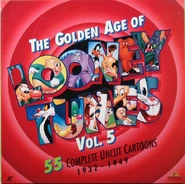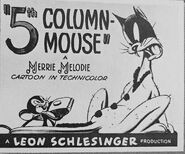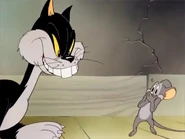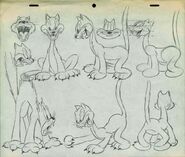The Fifth-Column Mouse is a 1943 Merrie Melodies short directed by Friz Freleng.
Plot[]
A pleasant group of mice are enjoying various water sports in a kitchen sink, while singing the song "Ain't We Got Fun" in unison. Lurking nearby is a sinister black-and-white cat who gains the confidence of a dim-witted grey mouse. The cat persuades the unsuspecting rodent to tell the other mice to become the cat's slaves, and the cat promises a never-ending cheese supply in return.
The grey mouse (who much more resembles a rat) follows the cat's orders, but he soon finds out the cat's true intentions—to make them his dinner. At this point, the grey mouse finally realizes that the cat betrayed him and went back on the deal. The mice then form a united alliance against the cat as both sides prepare for war, where they defeat the cat by chasing him with a battleship resembling a bulldog and shaving the cat from head to toe with an electric shaver.
Having triumphed victoriously against the cat, the mice celebrate their victory, but when the grey mouse says "We dood it!" however they furiously throw a cream-pie right in the grey mouse's face, perhaps due to his betrayal towards them.
Caricatures[]
- Adolf Hitler
- Red Skelton - "We dood it!"
Availability[]
Cartoon Moviestars: Bugs and Daffy: The Wartime Cartoons
Cartoon Moviestars: Bugs and Daffy: The Wartime Cartoons
The Golden Age of Looney Tunes, Vol. 5, Side 3: Freleng Follies (dubbed version)
Looney Tunes Golden Collection: Volume 6, Disc 2 (Blue Ribbon reissue)
Censorship[]
- Due to its heavy World War II references, this short rarely, if ever, airs on American television. In the rare times it does air on an American TV network, specifically TBS, TNT, Cartoon Network, and Boomerang, the version they play cuts the part where the mouse refuses the cat's deal of all the cheese that the mouse wants in exchange for leading the mice population to appease the cat, but the cat forced him to accept the deal, followed by, "NOW, GET GOING!"[5] because of the cat briefly looking stereotypically Japanese and the mouse giving a Hitler salute to the cat. The edit goes from the cat whispering into the mouse's ears, then fades over to the next scene with the mouse telling the other mice about the deal [6]. It should be noted that Cartoon Network's and Boomerang's overseas feeds (evident by the video in the infobox) aired this scene uncut.
- When the film was re-released in 1950, a small line of dialogue was cut during the "Ain't We Got Fun?" musical number. The original line was "Down with the Axis, we're all glad to pay our taxes."[7] This was likely cut due to explicit reference to the Axis powers.
Goofs[]
- In the 1950 reissue, the lyrics suddenly stop near the end of the sequence. This does not occur in the original release.[7]
- When the mice are serving the cat, the cat sits up and a mouse passes through his head.
Notes[]
- The unnamed grey mouse from this cartoon bears a strong physical resemblance to the mice duo Hubie and Bertie, a Chuck Jones creation, which would debut later that year in "The Aristo-Cat".
- The USA 1995 dubbed version is on The Golden Age of Looney Tunes Vol. 5 LaserDisc, although it was previously released on Bugs and Daffy: The Wartime Cartoons VHS and LaserDisc with its original BR ending card intact. Prior to its remastered and restored release on Looney Tunes Golden Collection Volume 6, the latter home media release was the only official home media release of the cartoon to survive its original BR ending card. Meanwhile, its original a.a.p. print survives on Cartoon Network Latin America (albeit with censorship as for syndication airings (see "Censorship" for more details), and the EU 1995 dubbed version keeps its original BR ending card, unlike the USA 1995 dubbed version.
- The European 1995 Dubbed print retains its original reissue ending title card (without the Dubbed notice), despite having spoken dialogue lines.[8]
- As with most cartoons of the time, this cartoon is laden with wartime references, and blatantly filled with Nazism themes. The cat represents Adolf Hitler, while the gray mouse (who much more resembles a rat) represents all of the people who choose to appease Adolf Hitler, including French Premier Edouard Daladier, and British Prime Minister Neville Chamberlain. The brown mouse who rails every one to fight the cat represents Winston Churchill, and the rest of the brown mice represent resistance fighters and those who faced discrimination against Hitler and his policies.
- As mentioned above in "Censorship", this cartoon rarely, if ever, airs on American television due to the heavy World War II themes. Despite this, it has been released on home media.
- When the cat is shaved near the end of the short, the remaining tufts of hair represent from right to left, dot-dot-dot-dash, Morse code for V (V for victory), representing the mice's victory against him.
- The scene where the mice shave the cat from head to toe with an electric shaver at the end of this cartoon is very similar to how the cat which chased Sniffles got shaved from head to toe by the electric shaver in "Naughty but Mice" (1939).
- This cartoon entered the public domain in 1971, due to United Artists' failure to renew its copyright in time.
- This short's Vitaphone release number is 913[9]
Music-Cues[10][]
- Three Blind Mice (traditional)
- Ain't We Got Fun (Music by Richard A. Whiting & Lyrics by Ray Egan and Gus Kahn)
- Sung by the mice at the beginning
- Under a Strawberry Moon (by Mabel Wayne)
- Plays when the cat offers cheese to the mouse
- Ach, du Lieber Augustine (traditional)
- Plays when the cat is whispering in the mouse's ear
- The Japanese Sandman (by Richard A. Whiting)
- Plays when the cat is done whispering in the mouse's ear
- Blues in the Night (by Harold Arlen & Lyrics by Johnny Mercer)
- Sung with substitute lyrics by the mice during the first meeting
- The Girl Friend of the Whirling Dervish (by Harry Warren)
- Plays when the mice are first tending to the cat
- All in Favor Say 'Aye' (by Cliff Friend)
- Sung with substitute lyrics by the mice during the second meeting
- We Did It Before [and We Can Do It Again] (Music by Cliff Friend & Lyrics by Charles Tobias)
- Sung by a chorus when the mice are marching
- Perpetuum mobile (Perpetual Motion), Op. 257 (by Johann Strauss)
- Plays when the mice are chasing the cat
- Symphony No. 5 Op. 67 I. Allegro con brio (by Ludwig van Beethoven)
- Plays briefly after the mouse shaves the cat
- We Did It Before [and We Can Do It Again] (Music by Cliff Friend & Lyrics by Charles Tobias)
- Sung by the mice at the end
Gallery[]
References[]
- ↑ https://www.facebook.com/photo/?fbid=10165808603900578&set=pb.619090577.-2207520000
- ↑ https://blueribbonblues.neocities.org/gallery
- ↑ http://likelylooneymostlymerrie.blogspot.com/2016/04/396-fifth-column-mouse-1943.html
- ↑ http://likelylooneymostlymerrie.blogspot.com/2016/04/396-fifth-column-mouse-1943.html
- ↑ http://www.intanibase.com/gac/looneytunes/censored-e-f.aspx
- ↑ https://mega.nz/#!FUQCVayY!1wjdrczu6qhryWI2NtTpQxAhh-LBnM6C3wCZgR4todY
- ↑ 7.0 7.1 https://www.youtube.com/watch?v=l_h8dZsTsHw
- ↑ http://www.dailymotion.com/video/x6esfdf
- ↑ https://www.google.com/search?q=Vitaphone+Films%2C+by+Roy+Liebman&sourceid=chrome&ie=UTF-8
- ↑ https://www.imdb.com/title/tt0035872/soundtrack/
- ↑ https://www.patreon.com/posts/whats-score-81644429
- ↑ https://books.google.com/books/about/Tunes_for_Toons.html?id=Rz2WJ_-NxsAC













